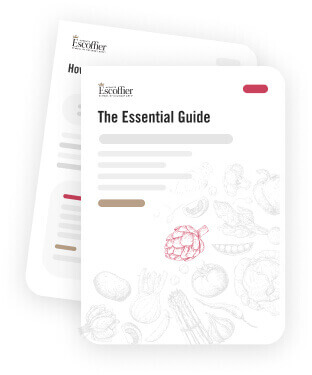Listen to This Article:
Picture this: You’re stepping into your first day of culinary school. For some, that can mean walking into a teaching kitchen buzzing with energy—chef whites on, knife roll in hand—ready for a day of hands-on practice and real-time feedback from Chef Instructors. For others, it can mean tying on that same apron in their own home kitchen, opening a laptop, and diving into interactive lessons that fit around work or family life.
In this guide, we’ll explore what it’s really like to attend culinary school, describing two formats—on-campus or online—from daily routines to externship opportunities. Whether you thrive in a bustling teaching kitchen or prefer the flexibility of learning from home, you’ll get a clear look at both paths so you can decide which one aligns best with your goals.
Let’s start by looking at the on-campus experience—what sets it apart, how a typical week might look, and where it could take you.
On-Campus Life: What Makes Culinary School Unique
Unlike traditional colleges where you juggle multiple subjects, culinary school is all about intensive focus. At Auguste Escoffier School of Culinary Arts, students in the culinary arts degree programs can concentrate on one to two classes at a time, diving deep into specific skills rather than spreading their attention across various topics.
Here’s some of what makes the culinary school experience unique:
Intensive, Hands-On Learning
Many culinary programs blend classroom study with hands-on kitchen training, allowing students to explore techniques, concepts, and industry standards before putting them into practice. For example, in Culinary Foundations, students split their time between the classroom and hands-on kitchen work.
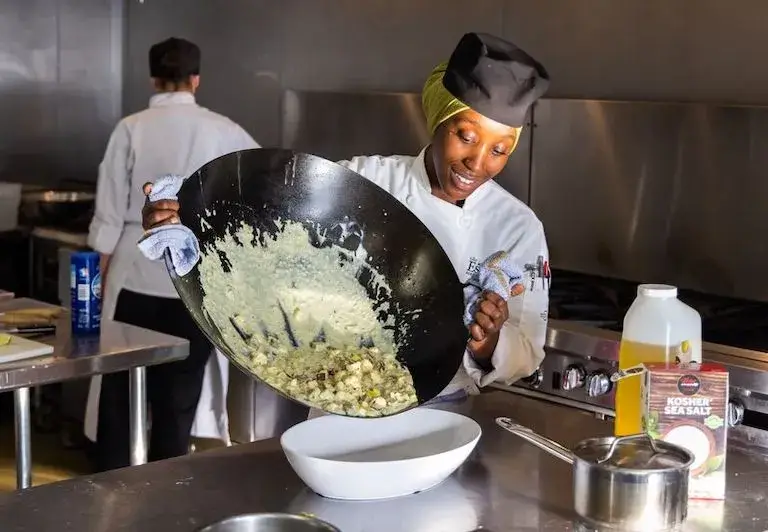
Hands-on practice is the heart of every culinary school day.
Small Class Sizes
Unlike traditional college courses with large lecture halls, on-campus culinary school classes are intentionally small. Whether you’re in a classroom session or a hands-on kitchen lab, working in smaller groups can mean you’ll have more opportunities for personal attention, feedback, and direct interaction with your Chef Instructors.
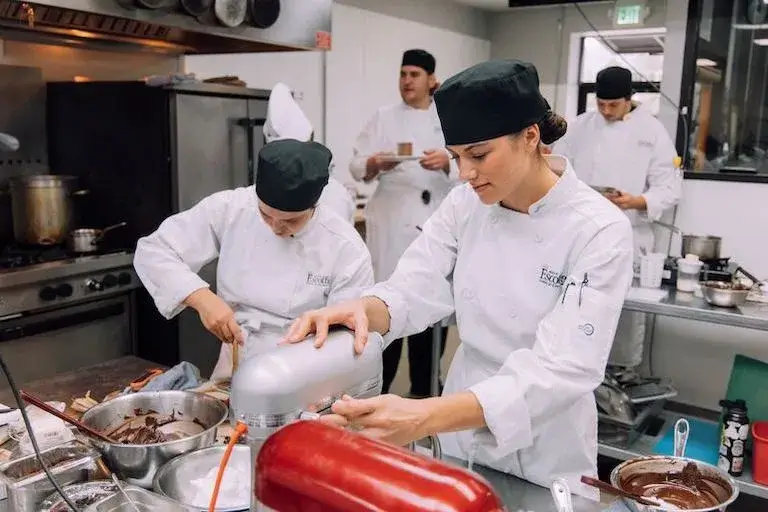
Small class sizes can mean more one-on-one time with Chef Instructors.
Professional Standards from Day One
Campus-based culinary school is all about adopting industry-level expectations for cleanliness, timing, and presentation. You can start practicing those professional habits right from the beginning in the teaching kitchens.
Physical Demands
Be prepared to spend hours on your feet, to move equipment, and to work around heat. It’s active, hands-on work that can help you build confidence, strength, and skill with every shift in the kitchen.
Time-Intensive Schedule
Culinary classes aren’t short lectures. For on-campus programs, classes often run in multi-hour blocks, giving you time to practice skills in depth. Unlike traditional college courses where you hop between classes, culinary students usually focus on one or two courses at a time, allowing for concentrated learning and hands-on experience.
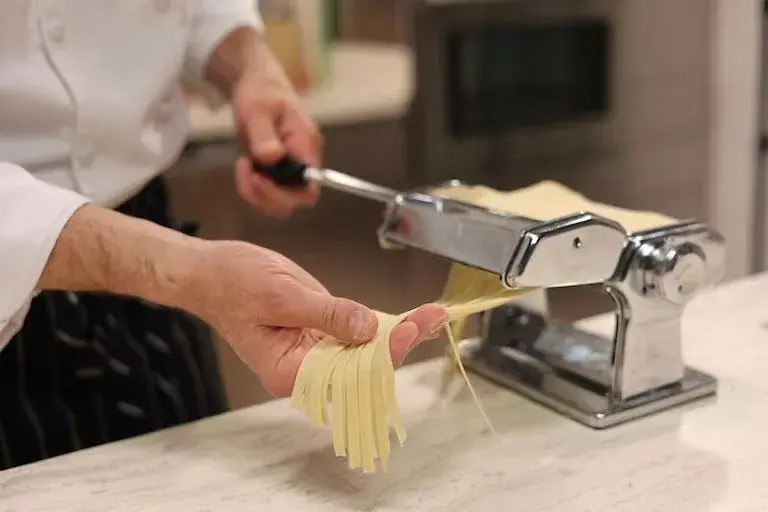
Building real-world skills, one fresh pasta sheet at a time.
Teamwork in the Kitchen
Here’s something that might surprise you about on-campus culinary school: it isn’t just about individual skills. Whether you’re coordinating multi-course meals or collaborating on elaborate showpieces, discovering how to communicate, delegate, and support your classmates is a key part of the experience.
Now that you understand what makes the culinary school experience unique, let’s dive into what your actual day-to-day experience can look like.
On-Campus Life: A Day in the Life of A Culinary Student
Daily life at culinary school is designed to reflect the structure and expectations of a professional kitchen. From the emphasis on organization and precision to the focus on timing, students can practice industry-level habits each day, building skills they can take straight into their culinary careers. Here’s what you might expect at culinary school:
A Typical Day
Specific hours may vary, but a typical day for an on-campus culinary student often starts long before the first dish hits the stove. While there are various schedule options available to students, here’s just one example of what your day might look like:
5:00 AM — Early Start
It’s an early wake-up, a quick breakfast, and maybe a glance over production sheets for the day before heading out the door.
6:00 AM — Arrival
Arriving on campus means changing into fresh chef whites.
6:00 AM-7:00 AM — Morning Briefing
The day can kick off with a quick briefing from your Chef Instructor: a review of recipes, techniques, and what’s expected during the morning lab.
7:00 AM – 10:00 AM — Kitchen Lab (Culinary Foundations)
The heart of the day is spent in the kitchen, putting skills into practice. These might include:
- Knife skills drills
- Classic sauce prep
- Cooking proteins and produce
- Plating and presentation techniques
- Cleanup (because kitchen sanitation is part of the craft!)
- HACCP principles
- Allergen awareness
- Cost control basics
- Menu planning strategies
10:00 AM – 11:00 AM — Cleanup
An hour to ensure the kitchen is cleaned up and set up for the next day of class.
After Class — Independent Study
Many students use their time after class to catch up on reading assignments, review the day’s lesson, or prepare their production sheets for the next day’s cooking assignment.
Evening — Rest & Reset
Early bedtime is key. Another packed day awaits tomorrow.
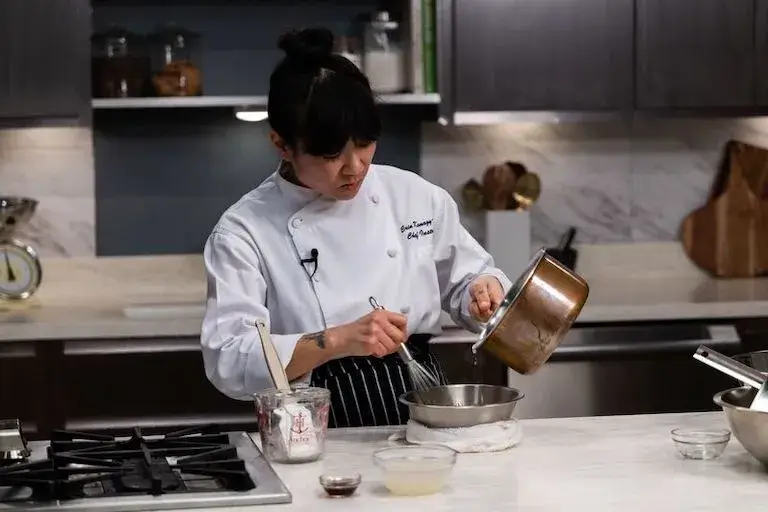
Combining theory with hands-on technique in every class.
On-Campus Life: Externship Experience
Every on-campus Escoffier student completes at least one hands-on industry externship—a chance to apply classroom and kitchen skills in a professional setting, work alongside seasoned chefs, and get a true sense of the pace and expectations of the industry. Whether your goal is a hotel kitchen, a neighborhood bakery, or a high-end catering company, your externship can help you build confidence, sharpen techniques, and make valuable connections.
In the final months of the program, students work with Career Services to identify ideal placements based on goals and location. Career Services can assist with resumes, portfolios, and interview prep, but it’s ultimately up to the student to choose and connect with their potential sites. Depending on the degree or diploma program, students are required to complete one or two externships with a commitment of 6-12 weeks.
Past Escoffier students have externed in a range of professional kitchens, from fine dining restaurants like Yolan and Frasca Food and Wine to luxury hotels including The Ritz-Carlton, Four Seasons, and the Biltmore Estate.
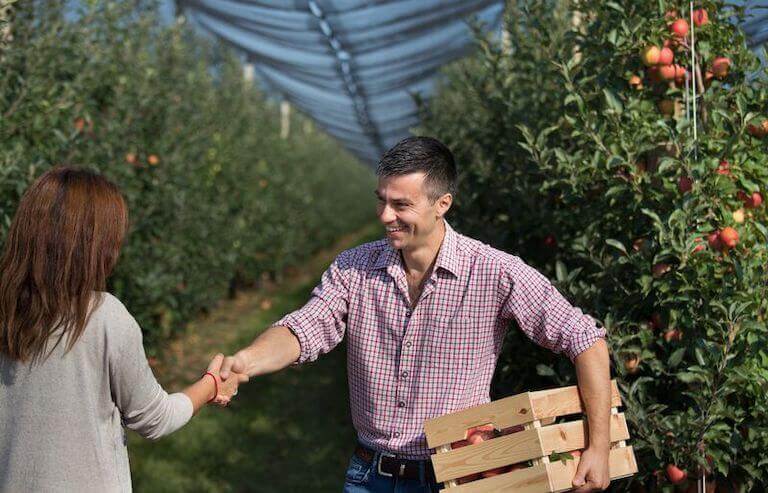
Culinary school can connect students to local food systems.
On-Campus Life: Building Professional Networks
Another valuable part of culinary school often happens outside the classroom: in the relationships you build along the way. From instructors and classmates to industry pros you may meet through school events and externships, these connections can help shape your career from day one.
Michael Fields, a graduate from Escoffier’s Austin campus, experienced this firsthand. When his instructors recognized Michael’s natural talent for barbecue, they didn’t just offer encouragement, they introduced him to Aaron Franklin of the legendary Franklin Barbecue. After a grueling four-hour heat test in a 130-degree pit room, Michael was hired on the spot and eventually worked his way up to front-of-house cutter at one of the world’s most respected barbecue restaurants.
For Michael, culinary school was about more than just learning recipes and techniques. It gave him confidence, credibility, and access to opportunities he might never have found on his own.
“Culinary school gives you the confidence you need to get in the door much more easily than if you were just to go work in a restaurant,”* he said.
*Information may not reflect every student’s experience. Results and outcomes may be based on several factors, such as geographical region or previous experience.
Smart Ways You Can Build Your Network While in School
- Attend local food festivals, competitions, and culinary events
- Join student chapters of professional organizations like the ACF or local guilds
- Engage with chefs and culinary leaders on social media
- Volunteer at community dinners, charity events, or school-hosted functions
- Engage with classmates on projects, competitions, or in clubs
How Culinary School Can Support These Connections
- Instructor introductions and industry recommendations
- Access to alumni networks and mentorship while enrolled
- Opportunities to showcase your work at school events or community partnerships
At Escoffier, the relationships you build during your program could help open doors—and can keep opening them—throughout your culinary career.
On-Campus Life: Cost Considerations for Students
Let’s talk money, because culinary school is a meaningful investment. You’ll need to consider tuition as well as potential additional fees like technology or equipment. Visit our tuition & fees page for updated information. For students who apply and qualify, financial aid is available, and Escoffier’s representatives can help walk you through your options.
To get the full view, you’ll want to consider the additional expenses that can come with your culinary education, especially for in-person students.
Additional Costs to Consider
While tuition covers core instruction, it’s important to plan for additional expenses that can come with in-person culinary school.
Equipment & Uniforms
Escoffier students receive a professional tool kit and uniform as part of program costs, but you may need to replace or upgrade items along the way. This can include additional chef coats or replacement tool kits.
Housing & Living Expenses
Escoffier does not offer traditional on-campus housing, but both the Austin and Boulder campuses partner with local student housing services.
In Austin, as of September 2025, shared housing starts at $859 a month, while shared housing in Boulder starts at $909 a month. Housing tiers include budget, basic, moderate, and premium price groups in both Austin and Boulder.
Other living expenses, like transportation, food, and uniform maintenance, will vary by location and lifestyle. Students are encouraged to budget for public transit, frequent uniform cleaning, and meal costs, especially for those cooking regularly at home.
*Information may not reflect every student’s experience. Results and outcomes may be based on several factors, such as geographical region or previous experience.
Financial Aid and Payment Options
Available funding can make the culinary school experience more affordable and accessible. Some options include:
Federal Aid Opportunities:
- Pell Grants: Up to $7,395 per year
- Federal Student Loans
- Work-Study Programs: On-campus employment opportunities
Escoffier-Specific Aid:
- Various scholarships are available, including competition-based awards, need-based assistance through the Escoffier Scholarship Foundation, military and veteran scholarships, and specialized grants for international students and industry partners.
- Military veteran benefits: Yellow Ribbon Program participation
- Payment plans: Monthly installments with no additional fees
- Corporate partnerships: Employer tuition reimbursement programs
Alternative Funding:
- Culinary industry scholarships
- State-specific workforce development grants
- Private education loans
On-Campus Life: Physical & Mental Demands of Culinary School
Attending culinary school in-person can be an incredible experience, but it can also be challenging. Success takes more than a love of cooking. It can require preparation for the physical demands of long kitchen hours and the mental focus needed to thrive in a fast-paced, professional environment.
What to Expect Physically
You can spend long hours on your feet, lift heavy pots or equipment, and work in hot kitchens where temperatures can climb to 85–95°F. Repetitive tasks, like chopping or whisking, are part of the job, and minor cuts or burns can happen despite being careful.
Smart Ways to Take Care of Your Body
- Practice proper lifting techniques
- Invest in supportive, comfortable footwear
- Build stretching or strengthening exercises into your routine
- Prioritize rest, aiming for at least 7–8 hours of sleep
- Eat well, even when your schedule gets hectic
What to Expect Mentally
The high-pressure environment of culinary school can test your mental resilience. Common challenges include working under tight time constraints, healthy competition with classmates, uncertainty about future career paths, and the perfectionist streak that can sometimes come with creative work.
Resources to Support Your Mental Wellbeing
- Access various student support programs or mental health services, depending on the campus
- Join student support groups or peer communities
- Seek mentorship from Chef Instructors
- Connect with industry professionals and alumni networks
- Explore workshops focused on work-life balance and stress management
Structuring Your Week & Managing Your Time
While every program and student schedule is a little different, most on-campus students follow a steady rhythm of class blocks—splitting time between kitchen labs and classroom instruction—along with dedicated periods for studying, assignments, and rest. Building a routine that balances these demands can help keep you organized and energized.
Some helpful habits include:
- Prep ahead: Have uniforms cleaned, knives sharpened, and notes reviewed before class days.
- Fuel wisely: Pack high-protein snacks, stay hydrated, and plan balanced meals to keep your energy up.
- Use transition time: Short breaks between tasks or classes can help you reset and stay focused.
- Set an evening routine: A quick review of the day, planning for tomorrow, and getting enough rest can make a big difference in stamina.
Good time management not only supports success in culinary school, it mirrors the organization, preparation, and pacing that are essential in professional kitchens.
Online Culinary School: A Flexible, Professional Path
While on-campus learning is a fit for many, others may prefer or rely on the flexibility of an online program. Work, family commitments, or location can make a traditional school schedule tough to manage. That’s why Escoffier’s online programs can offer a flexible option for students who want a professional culinary education with the convenience to learn when and where it works for them, so long as they meet their assignments’ weekly due dates.
You can build essential skills, practice hands-on techniques, and get personalized feedback from Chef Instructors, all while fitting your education into your life. You can be putting on the same chef whites, unrolling your knives, and rolling up your sleeves, just in your own kitchen.
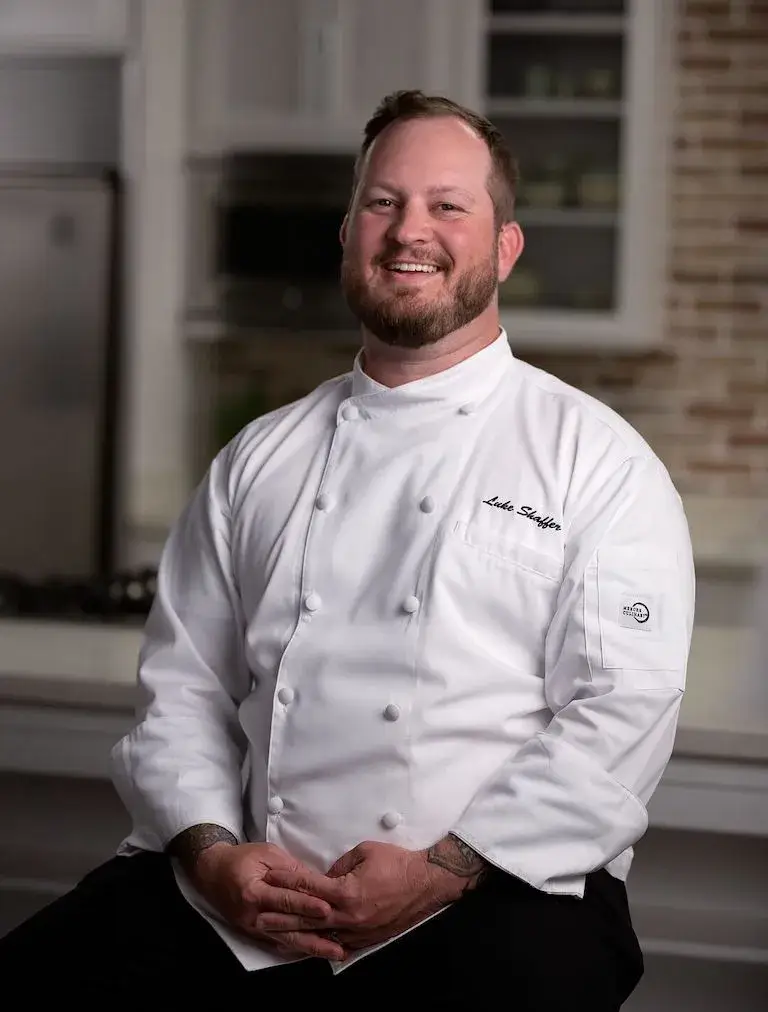
Chef Instructor Luke Shaffer brings years of industry experience to the online classroom.
For some students, like Escoffier graduate Bree Chumley, online learning offered a way to pursue culinary education in a format that fit her health needs and lifestyle. Bree said she appreciated the option to study online even after businesses reopened after the pandemic.
“The world was kind of coming back alive with going outside, but I’m a Type 1 diabetic, so I was still staying at home a lot of the time,” she said. “So virtual culinary school came in at a perfect time for me to just try something different.”
Today, Bree works as a personal chef from her Cleveland home kitchen, creating customized plant-based meals for clients while developing more than 150 handmade spice blends.
Online Path: A Week in the Life
As an online culinary student, you’ll structure your week around a mix of coursework (such as assignments, discussion forums, or quizzes), kitchen practice, and instructor feedback on a schedule that works for you while still meeting necessary deadlines. Here’s what that experience can look like:
Coursework & Learning
- Participate in 1-2 live video class sessions per week or watch the recordings.
- Explore reading assignments
- Review technique videos to prepare for hands-on practice.
Hands-On Kitchen Practice
- Practice essential techniques from your home kitchen.
- Document your process and finished dishes with photos.
- Submit your work for personalized evaluation and feedback from Chef Instructors, then apply that feedback to your next practice session.
For online culinary students, each week runs from Wednesday to Tuesday, with all assignments due by Tuesday at 11:59 PM CT.
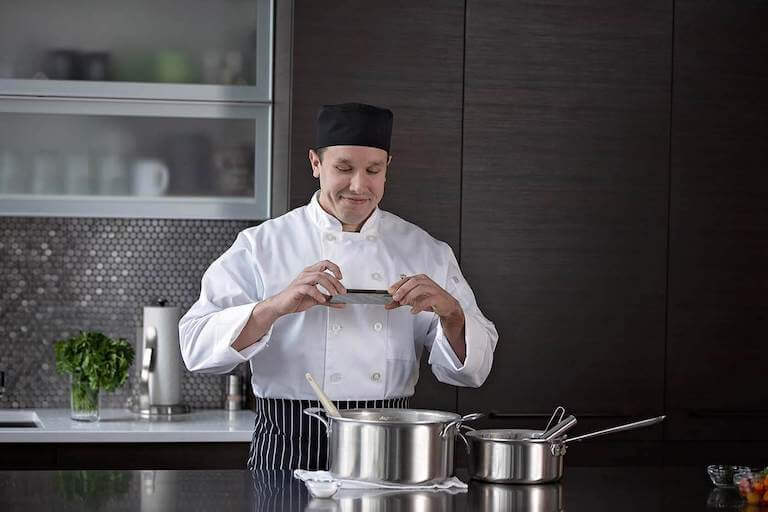
Today’s culinary skills can include food photography for portfolios and social media.
Online Path: Your Externship Experience
Online students at Escoffier also complete at least one hands-on industry externship, giving them the chance to step out of their home kitchens and into the professional food world. Working with Career Services, students can get advice and recommendations for potential sites, then they take the lead in securing a placement that aligns with their goals—whether it’s close to home, in another city, or even another country.
This real-world experience can take many forms, from assisting a pastry team in a boutique patisserie to joining the prep crew at a farm-to-table restaurant, helping with banquets at a resort hotel, or learning production flow in a specialty food shop. It’s an opportunity to put skills into action, make industry connections, and explore the settings that inspire you most.
Online Path: Building Your Professional Network
Even without a campus setting, online students can create valuable connections:
- Attend local food events and competitions
- Join online culinary communities, such as Escoffier’s Club Hub, to share ideas in interest-based groups like the sourdough or pizza clubs
- Network during externships
- Connect with chefs and alumni on social media
Online Path: Cost Considerations for Students
The online Associate of Occupational Studies degree includes tuition, a professional tool kit, uniform, and digital textbooks. Visit our Programs page for updated tuition and fees. While you may need to replace or upgrade items like knives or additional chef coats during the program, online students can often save on costs tied to relocation, campus housing, or daily commuting.
It’s also important to budget for reliable internet service and any technology needed to support your coursework, such as a computer or tablet that meets program requirements. Students can purchase a laptop through Escoffier as part of their tuition. The total program cost encompasses tuition, tool kit, uniform, and an optional non-refundable technology fee if you do not already have a computer.
Online Path: Physical & Mental Demands for Remote Learning
Online culinary training may not involve long days on your feet in a shared kitchen, but it still requires focus, discipline, and stamina. Practicing from home can mean taking charge of your own schedule, and managing assignments without the structure of in-person class times.
Physically, you may still spend hours standing, chopping, whisking, and lifting equipment, so comfortable footwear and an organized workspace can make a big difference. Mentally, it’s important to set clear goals, create a distraction-free environment, and maintain consistent habits that keep you engaged with your coursework.
Strong self-motivation, effective time management, and the ability to practice and problem-solve independently can be key to thriving in an online program—and are the same skills that can serve you well in a professional kitchen.
Culinary School Formats Compared: On-Campus, Online, and More
So far, we’ve looked at what life is like in Escoffier’s on-campus and online programs. But those aren’t the only options for culinary education. The right choice depends on your goals, schedule, and learning style, and schools can vary widely in format and focus.
The chart below offers a broader look at the main types of culinary education—so you can compare on-campus and online programs alongside other pathways such as community colleges, short-term certificates, and traditional four-year colleges.
Culinary School Types Comparison Chart
This chart gives a broad overview of the different types of culinary education available, helping you decide which format might fit your goals, schedule, and learning preferences.
| Type of Program | Typical Program Length* | Learning Environment | Hands-On Training | Flexibility |
|---|---|---|---|---|
| On-Campus Dedicated Culinary School | 12–24 months | In-person kitchen labs and culinary classrooms | Extensive, structured kitchen instruction | Fixed schedule |
| Ground Campus (Community College) | 18–24 months | In-person classes, general + culinary courses | Moderate, often fewer hours than private schools | Fixed schedule |
| Online Culinary School | 12–21 months | Learn from home with online lectures + kitchen practice | Moderate to extensive (via home kitchen + externship) | High flexibility |
| Short-Term Certificate Programs | 3–12 months | Accelerated programs, some evenings/weekends | Limited to moderate, varies by program | Moderate flexibility |
| Traditional Four-Year College | 36–48 months | Full-time academic setting, general ed required | Varies—may be limited outside culinary core | Less flexible (full degree program) |
*This information may not reflect all institutions. Length of program, training, and flexibility may vary.
Additional Key Factors to Consider
Program Structure:
- Do you prefer intensive, focused learning or broader curriculum?
- Is flexibility important for your schedule?
- How important are small class sizes to your learning style?
Location Impact:
- Urban vs. suburban campus environment
- Cost of living considerations
- Local industry opportunities
- Climate and lifestyle preferences
Specialization Options:
- Culinary arts vs. pastry focus
- Business and entrepreneurship emphasis
- International cuisine concentrations
- Farm-to-table and sustainability programs
Technology Integration:
- Online learning capabilities
- Digital portfolio development
- Industry software training
The right choice can shape your entire culinary school experience, so take time to visit campuses, speak with current students, and align your selection with your long-term career vision.
Career Outcomes & Job Search Assistance for Culinary Graduates
The culinary field offers promising growth opportunities for those interested in a culinary path. According to the U.S. Bureau of Labor Statistics, employment of chefs and head cooks is projected to grow 7% from 2024 to 2034, faster than the average for all occupations. About 24,400 openings for chefs and head cooks are projected each year, on average, over the decade. The median annual wage for chefs and head cooks was $60,990 in May 2024.
Curious about the highest paying culinary jobs? Read this.
Frequently Asked Questions
Understanding the culinary school experience means getting answers to the questions that matter most to prospective students like you. Here are some of the most common concerns.
Admissions & Prerequisites
Q: Do I need prior cooking experience to attend culinary school?
A: No prior professional experience is required. At Escoffier, we accept students with varying backgrounds, from complete beginners to those with some home cooking experience. The curriculum is designed to build skills from the foundation up.
Q: What are Escoffier’s admission requirements?
A: Admission requirements at Escoffier vary slightly by campus, but all applicants, whether online or on-campus, must complete an application, provide proof of high school graduation or equivalent, and participate in an admissions interview. On-campus students may also need to tour the facility and submit additional documents. Once you apply, an Admissions Representative will guide you through the next steps, including any required paperwork. Applications are accepted year-round for upcoming class terms.
Q: Is there an age limit for culinary school?
A: Students must be at least 16 years old to enroll. Beyond that, there’s no upper age limit. Escoffier welcomes everyone from recent high school graduates to later-in-life career changers.
Program Structure & Academics
Q: How challenging is culinary school academically?
A: Culinary school can be academically rigorous but in different ways than traditional college. You could expect:
- Intensive hands-on skill development
- Memorization of recipes, techniques, and safety procedures
- Time management under pressure
- Physical demands alongside mental challenges
- High standards for food safety and presentation
Q: Can I work while attending culinary school?
A: The full-time on-campus programs at Escoffier are designed to be immersive, with intensive class schedules that can make balancing a job challenging. However, there are three different daily start times available, which may help students coordinate their class schedule with part-time work.
Many students who need more flexibility choose Escoffier’s online programs, where coursework can be planned around work or family commitments while still offering hands-on training, professional feedback, and industry guidance.
Career & Job Prospects
Q: What’s the job market like for culinary school graduates?
A: The culinary field shows positive growth, with employment of chefs and head cooks projected to grow 7% through 2034, faster than average for all occupations.
Q: Do I have to work in restaurants after culinary school?
A: Not at all. Some additional career options outside of restaurants can include:
- Hotels and resorts
- Healthcare and senior living facilities
- Corporate dining
- Food production and manufacturing
- Catering and event planning
- Food media and styling
- Culinary education
- Food photography
- Food entrepreneurship and remote positions
Online vs. On-Campus
Q: Is online culinary school as good as on-campus?
A: Yes! Online programs can offer different advantages:
- Flexibility for working adults or parents
- No need to relocate, eliminating possible relocation or commuting costs
- Similar curriculum as on-campus programs
- Real instructor feedback through video submissions
- Different networking opportunities (local vs. campus-based)
Q: How do online culinary students get hands-on experience?
A: Online programs incorporate practical training in several ways:
- Required kitchen assignments where students watch chef demonstrations, then recreate the skills and techniques in their own kitchens
- Photo documentation of each step and final dishes for instructor review
- Externship opportunities—ranging from local job search assistance to international experiences—where students can apply their skills in a professional setting

Students can study pastry skills like precision piping and decoration.
After covering all of these details—from daily schedules to career prospects to financial planning—you should have a clear picture of what culinary school entails. Now comes the big question: is this path right for you?
Making Your Decision: Final Thoughts
Choosing to attend culinary school can be a significant investment in your future. The experience can challenge you physically, mentally, and creatively while opening doors to a diverse and growing industry.
Here are some key takeaways to consider:
- Research thoroughly: Visit campuses, talk to current students and graduates, and understand the total program cost, including tuition, supplies, living arrangements, and more.
- Consider your goals: Different schools and programs serve different career objectives. Align your choice with your 5-10 year career vision.
- Prepare financially: Understand all costs involved and explore every financial aid option available.
- Be realistic about challenges: Culinary school and the subsequent career path are demanding. Ensure you’re prepared for the physical and mental demands.
- Network actively: Your classmates, instructors, and externship supervisors become your professional network. Invest in these relationships.
Ready to Take the Next Step?
If you’re considering culinary school, you can start by visiting a campus to experience the environment, connect with admissions representatives who can help match programs to your goals, and/or chat with current students or recent grads who can offer valuable insight into the day-to-day experience. It’s also smart to explore financial aid, available to those who apply and qualify, and attend open houses early in your decision process.
The culinary world needs passionate, skilled professionals—and with the right preparation and dedication, culinary school can be the launchpad for a rewarding career. If one of these careers sounds exciting, contact us and let’s put a plan together to help get you started.
IF YOU ENJOYED THIS ARTICLE, CHECK OUT A FEW MORE:
- The Essential Guide to Careers in Foodservice
- Kitchen Hierarchy Explained: Different Jobs in the Brigade de Cuisine
- The Highest Paying Culinary Jobs and Positions
*This article originally ran on July 19, 2022, and has since been updated.
